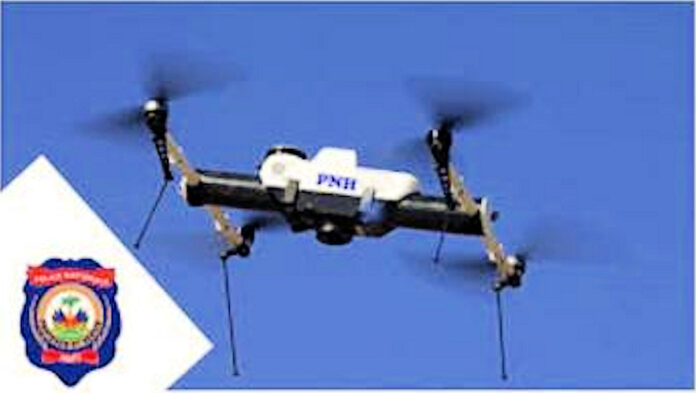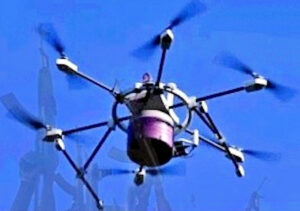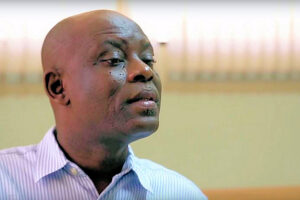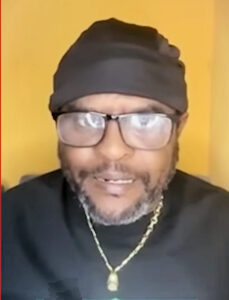
(Français)
A recent New York Times article explained that the kamikaze drone warfare currently being waged by Haiti’s Transitional Presidential Council (CPT) against Port-au-Prince’s armed groups is likely unlawful and violates an understanding with Canada.
The Royal Canadian Mounted Police (RCMP) had donated the drones and trained the Haitian National Police (PNH) on how to use them for surveillance of armed groups, the article reports.
“The drone attacks it has conducted are in violation of Haiti’s domestic criminal law and international human rights law,” RCMP spokesperson Marie-Eve Breton said in an email to the Times. “The RCMP does not condone the use of drones to carry munitions or offensive tools.”
According to Breton, Haiti’s government had promised not to use the drones to kill people. The “task force” that the Haitian government formed to weaponize the drones had “no legal authorities,” she said.

Breton’s comments contradicted a Mar. 18 Press Lakay report in which PNH deputy spokesman Lionel Lazarre said that “the Canadian government supported the initiative” of the CPT to form a lethal-drone task force.
The RCMP is distancing itself from the CPT’s drone warfare after several human rights experts have opined that the program violates international law, as Breton noted.
Godfrey Otunge, the commander of the UN-blessed, Kenyan-led Multinational Security Support Mission (MSS) in Haiti, also said that his force does not use “weaponized drones” and that the CPT “is in charge,” according to the Washington Post.
An anonymous Haitian official showed no concern for the civilian casualties that cause the RCMP and MSS to disassociate from the drone warfare.
“Let’s be honest — it’s inevitable,” the official told the Post. “To me, it’s just a detail. As long as you’re in a zone controlled by gangs and there are attacks, collateral damage is going to happen.”
With Canada and the MSS taking their distance, the current CPT interim president Fritz Alphonse Jean admitted recently that the government had hired “foreign mercenaries” to operate the kamikaze drones, mercenaries assembled by the infamous Erik Prince, founder of Blackwater and a host of other “military contractor” firms.
The CPT hires Erik Prince to conduct kamikaze drone program
“Haiti’s government has hired American contractors, including Mr. Prince, in recent months to work on a secret task force to deploy drones meant to kill gang members,” reported the New York Times on May 28.

The article reports that Prince’s team has been operating the drones since March, which is when the first attacks began. Quoting anonymous “security experts,” the article explains that Prince has “also been scouting Haitian American military veterans to hire to send to Port-au-Prince and is expected to send up to 150 mercenaries to Haiti over the summer.”
Prince also “recently shipped a large cache of weapons to the country,” the experts said.
An anonymous Haitian government official told the Times that “secrecy about the [drone] operations was imperative to avoid tipping off gang leaders,” suggesting this justified hiring private contractors from the U.S. because it would mean “fewer leaks of information.”
Prince: “It’s time for us to put the imperial hat back on”
The Times article comes two months after reports revealed that Prince is also contracted to “help Democratic Republic of Congo (DRC) secure and tax its vast mineral wealth.” The contract with Prince follows a “broader deal on critical minerals partnerships” between the DRC and the Trump administration.
Prince is a big Trump supporter, having donated $250,000 to his 2016 presidential campaign, and Prince’s sister, Betsy DeVos, served as Trump’s first Education Secretary.
Prince is also a vocal supporter of colonialism and U.S. imperialism. In an Off the Leash podcast, Prince said“it’s time for us to just put the imperial hat back on, to say, ‘we’re going to govern those countries.’”
“You can say that about pretty much all of Africa, they’re incapable of governing themselves,” Prince continued. In an article for The Intercept, journalist Jon Schwarz explained that Prince later “added that he thought this was a great concept not just for Africa but also for Latin America.”
Prince is not formally working on behalf of the Trump administration, but it is unlikely that he offered his services to the CPT without approval from the U.S. State Department.

In an interview with Responsible Statecraft, Sean McFate, a former contractor and author of “The Modern Mercenary: Private Armies and What They Mean for World Order,” explained that Prince was acting as “an opportunist aligned with Trump,” playing on Trump’s obsession with the migration of “illegal aliens” from the Global South into the U.S..
“What’s different this time”, McFate explained, “is that [Prince is] not really pitching contracts to Washington. He’s pitching contracts in cooperation with what he thinks is Washington… He’s finding clientele who are not Americans, but he’s doing it with the blessing he thinks [he’ll get], or wants [from] Trump.”
It may be that Prince’s desire for overt U.S. imperial domination of Africa and Latin America will appeal to Trump, who has disbanded U.S. soft-power institutions like USAID and the United States Institute for Peace (USIP).
Haitian human rights groups support kamikaze drone program
One of the most surprising aspects of the CPT’s illegal drone warfare program is the enthusiastic support provided it by Haiti’s so-called “human-rights groups,” including FJKL, RNDDH, POHDH, CARDH, and Collectif Défenseurs Plus.
Most of these human rights groups are in some way funded by the National Endowment for Democracy (NED), the Canadian government, the Open Societies Foundation (OSF), or American Jewish Voices for Peace (AJWS). Consequently, they do not challenge U.S. imperial domination of Haiti.
The most widely cited of these groups, the RNDDH, is also the most notorious. It is generally regarded as a political organization, and its director, Pierre Espérance, a political operator.
Espérance is aligned with sectors of the “Patripoche” or enlightened bourgeoisie via the Montana Accord, which used to meet in his office. For the moment, the Montana Accord’s CPT representative, Fritz Jean, is running the dysfunctional interim government.
Espérance has used the RNDDH to target political rivals with false allegations of criminal wrongdoing.
This has gone as far as playing a key role in the propaganda campaign that framed Fanmi Lavalas (FL) and its leader, Jean-Bertrand Aristide, as a tyrannical movement undermining Haitian democracy. This led to the 2004 coup d’etat, backed by the U.S., Canadian, and French governments, that ousted Aristide and thousands of other elected FL officials. A campaign of terror followed that saw the RNDDH work with the coup regime to aid the PNH in a terror campaign that targeted FL leaders and militants.

A common feature of RNDDH propaganda is manipulating numbers of victims or framing violence in their reports to suit their political ends.
For example, following the 2004 coup, the RNDDH worked with the coup regime to target FL leaders and members. In order to frame Prime Minister Yvon Neptune, Espérance and the RNDDH misrepresented as a state-sanctioned “massacre” the battle between government forces and their popular organization (Balewouze) allies against a quasi-paramilitary group named RAMICOS in La Scierie.
RAMICOS supported Aristide’s overthrow. The battle between RAMICOS and government-aligned forces resulted in several fatalities, including some non-combatants.
The RNDDH misrepresented these deaths as being the result of a “massacre” ordered by Neptune, leading to his illegal imprisonment without trial for two years after the 2004 coup.
The RNDDH fabricates figures to maintain support from drone program
The RNDDH claims in their recent report entitled “30th Anniversary of the Haitian National Police (PNH): RNDDH Commends the Struggle of Police Officers to Restore Security” that “at least 300 armed terrorist gang members have been killed, and more than 400 others have been injured, some of them seriously.”
It’s unclear why this was included in a report celebrating the PNH’s accomplishments, considering it clarifies that “to date, the PNH has had no involvement in the planning or coordination of drone-based operations.”
Furthermore, Jake Johnston at the Center for Economic and Policy Research (CEPR) recently pointed out that during the period of January to May 2025 “the UN reported 2,680 people were killed in Haiti. Nearly 60% were killed by police, and that share has been increasing recently.”
This includes the case of Haitian-American truck-driver and entrepreneur Weithzer Ervens Fénélon who was kidnapped and murdered by PNH officers near Port-de-Paix in March. Witnesses allege that following his brutal murder, PNH officers severed his head and limbs and burned his body.
“As long as you’re in a zone controlled by gangs and there are attacks, collateral damage is going to happen.”
The RNDDH’s desire to celebrate the PNH stands in stark contrast to the police force’s actions. The RNDDH does not substantiate their drone-kill figures with any recordings, data, or names, nor does it say anything about the “inevitable” civilian deaths.
Indeed, to redress insecurity, the PNH has largely used two tactics: first, it has carried out unprovoked murder, torture, disappearances, and terrorization of unarmed civilians living in or near territory controlled by armed groups and, second, it has attacked protestors.
Given the RNDDH’s history of manipulating reports for political ends, and the lack of proof to support their claim of 300 dead and 400 injured “terrorist gang members,” one can presume the numbers are invented or inflated and that civilian casualties have been omitted or misclassified.
These patently manufactured numbers aim to encourage further drone warfare against Haiti’s poor slums and have been uncritically cited across the local and international bourgeois media, thereby framing the drone warfare campaign as successful and uncontroversial.
Even Insight Crime, a “think tank” linked to the State Department and OSF, reported recently that security analysts they consulted said the RNDDH’s figures “could not be verified” and that the drone program has resulted in “mounting civilian casualties.” The report emphasized that “the Haitian government has not confirmed the number of those killed or wounded.”
In the Insight Crime report, Ayibopost’s editor, Wildore Mérancourt, said he could “confirm that civilians were harmed.”
Haitians demonstrate against drone program, demand the removal of the CPT
The “human rights” sector’s support for the kamikaze drone program reflects a general enthusiasm for the approach among Haiti’s bourgeoisie. Residents of elite quarters, representing the 10% of greater Port-au-Prince that is not controlled by armed groups, are heavily guarded by PNH units and are not at risk of becoming “collateral damage.”
In contrast, a Jun. 20 demonstration by thousands in the desperately poor southwestern flank of Port-au-Prince demanded an end to the drone program, the CPT’s removal, and for the U.S., Canadian, and French governments to stop meddling in Haiti’s affairs.
Krisla, a leader of the capital region’s armed group alliance Viv Ansanm, spoke to the demonstrators, expressing a widespread sentiment in many of Haiti’s poor neighborhoods: “Haiti is rich. These foreign mercenaries and powers are coming after our gas and mineral wealth, our gold.”
“We come from the popular quarters”, he said. “They say that people from our neighborhoods are not people. When Viv Ansanm comes to power, we will arrest many guys. Both politicians and bourgeois… They sell drugs, ammunition, guns, body organs. Then they put out the lie that it’s Viv Ansanm selling organs? The hospitals these things come from are not in our neighborhoods!… THEY are trafficking in organs. Everything they accuse us of doing, it’s THEY who are doing it…. One day, Haiti will change.”
Meanwhile, not a single armed group leader has been killed by these drone attacks.
Vitel’Homme, the leader of Kraze Baryè (Break down the walls), was injured following a drone attack. There are also reports that Izo, the leader of Village de Dieu’s Five Seconds armed group, was injured in an attack in early June.
The first kamikaze drone attack in early March against the principal Viv Ansanm leader and spokesman Jimmy “Barbecue” Cherizier injured 14 civilians and killed two others in a house filled with people with physical disabilities, Cherizier said. Only one of Cherizier’s men was seriously injured in the attack.
Haiti’s bourgeoisie back imperialist violence over dialogue with Viv Ansanm
While the murder of an armed group leader may provide useful propaganda for imperialist henchmen like Prince and the CPT, the strategic value is doubtful.
Analysts have pointed out that the successful murder of key leaders in Viv Ansanm would more likely increase the amount of violence in Port au Prince. Others have suggested that a Viv Ansanm alliance breakdown could “lead to internecine warfare among the gangs that increases the threat they pose to the government and to Haitian civilians.”
Meanwhile, Erik Prince’s mercenary units have a history of massacring civilians. The most notorious case was the 2007 Nisour massacre in Iraq, where Blackwater mercenaries killed 17 civilians. Blackwater contractors carried out dozens of other such massacres in Iraq.
The presence of Prince, the drone program, and a potential mercenary cohort increases the likelihood of more civilian deaths.

“Having mercenaries just go in and start executing people… is going to be just like the UN [interventions in the past],” said Institute for Justice and Democracy in Haiti (IJDH) director Brian Concannon in Responsible Statecraft. “It’s going to continue to undermine the rule of law and the social fabric and lead to just more rebounds of more trampoline effects of increasing gang violence.”
The CPT’s decision to hire a professed imperialist mercenary to operate a kamikaze drone program to kill Viv Ansanm leaders calling for revolution ought to dispel any remaining illusions that the interim government is anything but Washington’s tool.
The CPT and the political class’ refusal to engage in dialogue with Viv Ansanm denotes their class interest and dedication to U.S. imperial domination.
As the end of the Fritz Jean’s term as interim president draws near, the CPT is completely dysfunctional. Virtually all of the political parties and organizations who provided representatives to the CPT have withdrawn their support.
On Aug. 7, Laurent Saint-Cyr, the literal representative on the CPT of Haiti’s oligarchs (generally called the “business sector”), will become the final interim president. Saint-Cyr has signaled that he has shifted his support from the “enlightened” bourgeoisie sector of the Montana Accord (Fritz Jean), Lavalas Family (Leslie Voltaire), and January 30 Collective (Edgar Leblanc) to its rival faction composed of the December 21 Accord (Louis Gérald Gilles), EDE/RED (Smith Augustin), and Dessalines Children (Emmanuel Vertilaire).
“If you are nationalists, what’s happening should revolt you. Let’s unite and write history.”
Meanwhile, organizing fair elections before the end of the CPT’s mandate on Feb. 7, 2026 is clearly impossible. There is not even an electoral council yet, nor an electoral law.
The leadership vacuum in government has prompted Washington to try concocting yet another invasion force through the Organization of American States (OAS).
But calls from abroad for negotiations with Viv Ansanm have increased. Dominica’s Prime-Minister, Roosevelt Skeritt, has called for dialogue, pointing to the successful deal in Colombia between FARC and the government. Pan-Africanist leader Kemi Seba has calledfor Viv Ansanm to be a liberation army for the Haitian people, which is also Jimmy Cherizier’s often-articulated goal. CEPR’s Jake Johnston also laid out the rationale for dialogue months ago.
Another important call for dialogue with Viv Ansanm came from the new OAS Secretary General Albert Ramdin, who said one way to improve security would be “trying to find inroads in the gangs and in the leadership.” He wants to get the Viv Ansanm “on board to normalcy.”
Cherizier has called for negotiations on several occasions. He recently said: “The only thing that can extract Haiti from the hole it is in right now is dialogue. Let us talk to each other and explain what we need.”
The Overton window on the need for dialogue with the armed groups seems to be opening in Haiti’s bourgeoisie as well. A recent Ayibopost article by anthropologist Isabelle Clérié bemoaned the lack of understanding of the current crisis’ socio-historical roots while emphasizing the need for mutual understanding. “We are all victims, just as we are all guilty,” she wrote. “It is our peace to define and ours to foster, and for this we will have to forgive each other.”
Meanwhile, on Jul. 5, Cherizier made an sensational video expressly addressed to Haiti’s police, army, and their allied “brigade” paramilitary units. “Haitian people, wake up. Wherever there are brigades, it is to protect the CPT or the Prime Minister,” he said. “They are not there to fight Viv Ansanm or Barbecue.”
Then he called on all of Haiti’s armed forces to drive the CPT and Prime Minister Alix Didier Fils-Aimé from power, “to unite to build something.”
“Why don’t we all unite together to liberate this country?” he asked. “Viv Ansanm is ready. Some brigade member yelling ‘Down with the state!” is bluffing. Unite with other brigade members, the police, and the army and take power. When you have power, if you want to negotiate with Viv Ansanm, we’ll negotiate. If you don’t want to negotiate with Viv Ansanm, now you don’t have to yell about ‘the State!” because it will be in your hands, and we’ll march on you.”
“Police, soldiers, brigadiers, it’s up to you,” he continued. “I’m not asking you to join with Viv Ansanm. I’m asking you three to unite and resolve this problem, remove those nine [CPT] thieves and the disgusting Prime Minister… Be brave enough to do it. If you’re not going to do it, cross your arms and let Viv Ansanm do it… If you are nationalists, what’s happening should revolt you. Let’s unite and write history.”
“If you’re not going to do it, let me get by [bam pase] to do it,” he concluded. “The nation can’t remain like this. Let me by to do it. I’ve become conscious.”
Travis Ross is based in Montreal, Québec. He is also the co-editor of the Canada-Haiti Information Project at canada-haiti.ca. Travis has written for Haiti Liberté, Black Agenda Report, The Canada Files, & TruthOut. He can be reached on X.










[…] (English) […]
[…] role in setting up Haiti’s weaponized drone program was only revealed by The New York Times two months after it began, revealing that there is no […]
[…] le dysfonctionnement persistant au sein du CPT. Le rôle de Prince dans la mise en place du programme de drones armés d’Haïti n’a été révélé par le New York Times que deux mois après son lancement, […]